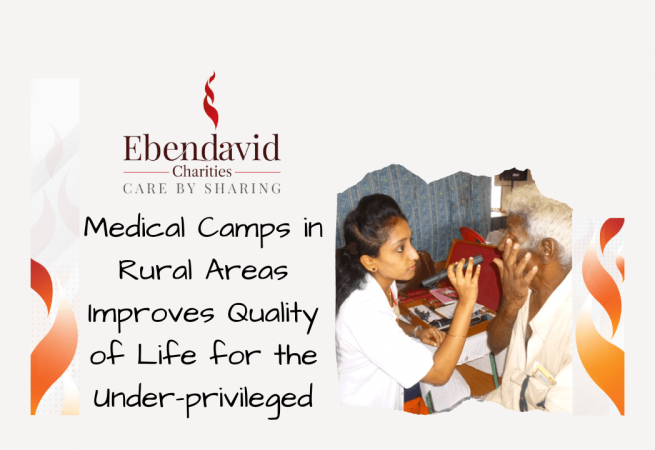Medical Camps in Rural Areas Improves Quality of Life for the Under-privileged

Table of Contents
Medical Camps in Rural Areas Improve Quality of Life for the Under-privileged
When one thinks of rural India, One might picture farmers toiling away on green pastures, children playing hopscotch on a small school ground, or women carrying pots of water atop their heads in a straight line. Although these people live much simpler lives than ours, these lives are often short. According to data from 2015-2019, on average, rural Indians live for 68.3 years, compared to urban who live up to 73. That is a wide gap of 4.7 years. And remember, this is just an average.
What are the main health issues in rural India?
Life expectancy is limited because of family history and poor health conditions. Some of the significant health issues gripping rural India are diseases that are often contagious, infectious, and waterborne. Some examples of these are diarrhea, worm infestations, tuberculosis, and respiratory infections, being the major causes of death in this population.
Working conditions are often another determining factor in health issues. According to an article by the MacArthur Foundation, after having experienced the economic boom of the COVID-19 pandemic, rural individuals would like to see a change in their workplace. Starting with a large difference between daily wages in states such as Madhya Pradesh (INR 193) and Haryana (INR 350), which must be solved by paying employees regularly and on time.
On the other hand, some rural place asset creation on a higher pedestal than wages. They wish to participate in government schemes that offer some means of generating their own personal assets, like rainwater harvesting systems for farmers, who would benefit from the free, increased water resource to utilize in irrigation. These schemes could aid individuals in seeking long-term increases in their incomes, by increasing efficiency and reducing their operating costs, preventing them from future financial burdens that might reduce their chances of paying hospital bills.
Positive and Negative Consequences of COVID-19 on Rural Healthcare
Due to the consequences of the pandemic, employers who usually employ informal labor, preferred to hire younger, male employees between ages 18 and 40. For this to change, there must be greater acceptance among employers who employ informal labor and must be more accepting of older, and female employees to fill their job vacancies, including a higher proportion of recruited applicants being women, migrants, and people with disabilities (special needs). This allows more individuals to be able to financially support their spouse and children, as well as afford basic healthcare services.
The onset of COVID did lead to more health education and awareness programs across schools and communities, such as FMC, which partnered with ARDEA to run a daily television episode over 20 days, educating the rural communities. Titled ‘COVID-Free Village’, the episodes featured medical experts who debunked myths about the infectious disease, providing information about COVID, and answered any viewers’ questions and worries through Livestream.
Such community empowerment methods were drastic measures to keep hospitalizations from this disease at bay, revealing the work that has yet to be done in terms of access to basic healthcare centers and accurate healthcare information, which are the top barriers to health in rural areas.
What happens in a medical camp and how are they conducted?
The definition of a health camp or medical camp is to screen all patients in a village, dispense health-related information, distribute medicine for common ailments, additionally referring individuals to get surgery or treatment at hospitals for serious conditions.
Medical camps are organized by several doctors, such as general physicians or specialists on certain diseases along with nurses to help them carry out their consultations and procedures. They carry a variety of medical drugs depending on the common occurrence of a particular disease within a community. Instruments are vital in their operation, and they range from basic cotton and disposable needles to ECG (Electrocardiogram) and BP (Blood Pressure) machines.
Some examples of types of health camps are such as those for incurable diseases like chronic skin conditions, stress camps that prevent stress as a factor that prolongs disease, as well as fitness camps that educate obese and malnourished individuals to exercise alongside consuming nutrient-rich portions of food.
Free health check-up camps and medical camps, as their names suggest, offer services that are free of cost to people who might benefit from them, being the individuals of rural communities. Expenses are covered by donations to NGOs, who usually organize them across several villages in various districts.
What are the benefits of attending a health check-up camp?
The main benefits to villagers who attend these medical camps are that doctors and professionals will be able to identify early signs of diseases and prevent them from developing into serious complications. They provide high-quality health care that usually varies between different healthcare institutions, as well as work with their patients to build a better, more disease-resilient community that can make long-term changes to their living standards and lifestyles.
What are the main government health programs implemented in rural India?
Reproductive, Maternal, Newborn, Child and Adolescent Health, abbreviated as RMNCH+A, is a healthcare program launched by the Indian Government to help empower women to regulate their fertility, pregnancy, and childbirth safely, increasing successful childbirth and survival of mother and child. It particularly focuses on women being able to access health care services as early as possible as well as interventions for defects at birth.
Another program is Pradhan Mantri Swasthya Suraksha Yojana, shortened to PMSSY, which focuses on smoothening out regional imbalances and inequalities with regard to accessing health care as well as aiming to improve the quality of medical education by setting up institutions like AIIMS and upgrading existing government medical colleges. The goal of PMSSY is to increase the number of super-specialties that students can pursue and more seats for admitting students
Finally, how can you sponsor a medical camp in India?
We, Ebendavid Charities, are a proud NGO in Tamil Nadu that rise up to challenges faced by the communities that we serve and offer a helping hand. We just conducted a free medical camp at Kanchivayal village in January of this year by partnering with medical professionals from the nearby A.C.S Hospital, with humble volunteers helping the disabled and elderly to access the camp services.
By donating to us, you not only help us continue conducting medical camps in the future, but you will also support needy individuals from rural communities who lack access to basic, high-quality healthcare. We appreciate your contributions.
Leave a Reply
You must be logged in to post a comment.













